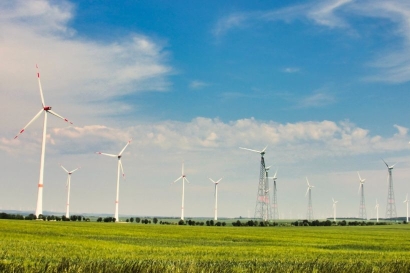Industry Research Insights
5 MAY 2024
On the evening of May 3, 2024, the Hong Kong Monetary Authority officially announced the extension details of the Green and Sustainable Finance Funding Scheme. The green and sustainable finance subsidy policy that has attracted much attention from the market has finally been officially released and confirmed. The new green and sustainable finance funding scheme will be implemented on May 10, 2024 for a period of three years. In addition to continuing to support the relevant green and sustainable debt financing instruments of the previous period, the new funding scheme will cover financial instruments such as transition bonds and transition loans to promote enterprises to use Hong Kong's financing platform to accelerate low-carbon development. CCXGF International believes that the extension and expansion of the funding scheme will continue to promote the development of Hong Kong's green and sustainable financial market and continue to enhance Hong Kong's competitiveness in building an international financial center. Since the current funding scheme was officially launched in May 2021, the Hong Kong SAR Government has funded more than 390 green and sustainable debt financing instruments in three years, with a financing scale of more than US$110 billion. The subsidy scheme has also become an important support for the development of green and sustainable development finance in Hong Kong in the past three years, allowing Hong Kong to remain Asia's largest green and sustainable bond arrangement and issuance center. (For details, please click "Read the original text") Compared with the original funding plan, the new funding plan has three major characteristics: Covering transition financial instruments and requiring disclosure of transition plans or programs The new funding program guidelines clearly propose to include transition bonds and transition loans in the funding scope. At the same time, sustainable development-linked bonds and loans and social responsibility bonds and loans are also clearly written into the funding guidelines. At the same time, the benchmarking and analysis of transition financial products should refer to internationally accepted standards or classification catalogues. It is expected that the above-mentioned financial instruments will become an effective means to continue to support Hong Kong in developing a green and sustainable financial market. Different from the current application for green and sustainable financial instrument subsidies, when applying for funding for transformation financial instruments, issuers or borrowers should submit and disclose their own corporate-level transformation plans and transformation paths. CCXGF International believes that this move will encourage more high-carbon enterprises that intend to raise funds in Hong Kong to accelerate their own transformation process. Benchmarking against Hong Kong Sustainable Finance Classification Catalogue The new funding scheme specifically mentioned the application of internationally accepted principles, standards and guidelines in the external review of pre-issuance external reviews when defining external review services, and specifically mentioned that the Hong Kong Sustainable Finance Classification Catalogue launched by the Hong Kong Monetary Authority on the same day could be used for external reviews. This move will also help enrich Hong Kong's experience in green finance standard building. Set a cap on pre- and post-issuance evaluation costs The upper limit of external review fees for a single eligible debt financing instrument remains at HK$800,000, but the new funding plan specifies that the upper limit of external review fees before issuance is HK$250,000, and the upper limit of external review fees after issuance is HK$200,000 per year. Clear fee guidelines will promote the healthy development of the green finance external review market. As the most important green finance market in Asia, the new round of green and sustainable finance funding program will continue to promote the development of Hong Kong's green finance market, provide more financing facilities for the majority of market participants, and attract more issuers, borrowers and financial service institutions to participate in the construction of the green and sustainable finance market. CCXGF International is the first Chinese rating agency to obtain the external review qualification for Hong Kong's green and sustainable finance funding program. Through China Chengxin's huge customer network and good market reputation, it provides high-quality green and sustainable finance external review services to issuers and borrowers. As China's leading green and sustainable financial service provider, CCXGF has a deep understanding of the dynamics of China's green finance market, and has accumulated rich project experience in the fields of green, sustainable, socially responsible and transformation bonds and loans, which has been highly recognized by customers and the industry.
VideoLEARN MORE
4 MAY 2024
On May 3, 2024, the Hong Kong Monetary Authority officially released the Hong Kong Sustainable Finance Classification Catalogue, which will serve as a voluntary market tool to guide the development of green and sustainable finance in Hong Kong, in order to continue to enhance Hong Kong's leadership in the green and sustainable finance market. Currently, Hong Kong's sustainable finance classification catalog includes 12 economic activities in four major industry sectors, including electricity generation, transportation, construction, water and waste management. As a local classification catalog in Hong Kong, the catalog was formulated with reference to five principles: 1. Consistent with the goals of the Paris Agreement; 2. Guiding the industry to avoid greenwashing; 3. Achieving compatibility with other regional classification catalogs; 4. Relevant goals and evaluation criteria are based on scientific evidence; 5. Adopting the principles of no major harm and minimum social security. In the process of formulating this classification catalogue, the Hong Kong Monetary Authority also referred to mainstream classification catalogues such as the China-EU Common Classification Catalogue, the China Green Bond Support Project Catalogue, and the EU Sustainable Finance Taxonomy to promote compatibility between standards and expand the liquidity of green financing products. Since the Hong Kong Monetary Authority released the first discussion document on the Hong Kong Sustainable Finance Classification Catalogue in May 2023, CCXGF International has actively participated in the public consultation on the classification catalogue. Based on its extensive project experience and huge customer network, it has proposed relevant industry green project analysis standards, included more projects in the classification catalogue and other practical experiences, and received special thanks and recognition from the Hong Kong Monetary Authority. Figure: The Hong Kong Monetary Authority expressed its gratitude for our work in the consultation process of Hong Kong’s Sustainable Finance Classification Catalogue As Hong Kong's leading green and sustainable financial services provider, CCXGF International will continue to actively participate in the construction of Hong Kong's green and sustainable financial market, continue to provide advice and suggestions for the formulation of subsequent transitional financial classification catalogues, promote the inclusion of more green industries in the classification catalogues, and contribute to Hong Kong's construction of an international green and sustainable financial center.
VideoLEARN MORE
13 MAY 2024
On April 12, 2024, the three major domestic stock exchanges officially launched the "Guidelines for Sustainable Development Reporting of Listed Companies (Trial)", and domestic supervision has officially launched the Chinese standard for sustainable development information in the capital market. The most striking thing is that this supervision has conveyed clear disclosure time and disclosure requirements. For the sample companies of the SSE 180, Science and Technology Innovation 50, Shenzhen 100, and ChiNext indices , as well as companies listed at home and abroad, the 2025 "Sustainable Development Report" should be disclosed for the first time in 2026 at the latest, and other companies are encouraged to disclose voluntarily. Build a sustainable development information disclosure framework and strengthen sustainable development information disclosure The guidelines issued by the three major exchanges have clearly put forward the disclosure framework of sustainable development information, carried out topic importance analysis around the four core contents of "governance, strategy, impact, risk and opportunity management, indicators and goals", and clarified the relevant disclosure topics. Clear disclosure requirements are of great significance to improving the disclosure quality of listed companies. At the same time, the guidelines encourage qualified companies to use scenario analysis and other methods to conduct climate adaptability assessments and hire third-party institutions to conduct greenhouse gas emission data verification or certification. The release of this guideline will effectively promote the disclosure of sustainable development information by listed companies in China, enhance the enthusiasm of listed companies for continuous disclosure, improve the disclosure quality of listed companies, and lay a good data foundation for in-depth ESG rating. CCX Green Finance International continues to provide ESG rating and disclosure services to listed companies As China's first-class credit rating agency, China Chengxin has been deeply involved in China's capital market for more than 30 years. Since the beginning of the development of China's green finance market, CCXGF has actively participated in the disclosure and rating of sustainable development information in the capital market. Relying on China Chengxin's 32 years of credit rating experience, CCXGF has developed ESG rating models for 57 industries, assigning different ESG rating weights to different industries based on industry characteristics and business attributes. It has rich practical experience in analyzing ESG key issues, showing deep industry accumulation, and has received good feedback from the market. At the same time, CCXGF has developed an ESG investor service platform, covering more than 6,000 A-share and Chinese Hong Kong-listed companies and more than 4,300 bond issuers, accumulating ESG rating data over the past four years, actively assisting listed companies and bond issuers in conducting ESG rating work, and providing investors with a good data foundation and rating basis. At the same time, CCXGF actively participates in the formulation of relevant ESG groups and industry standards, including the ESG Report Preparation Guidelines for Electronic Information Enterprises and the ESG Report Preparation Guidelines for Financial Leasing Enterprises, and actively publishes China Chengxin's views and voices at the ESG standard level to promote the widespread implementation of ESG business. ESG rating services can effectively guide the rated companies to improve their ESG management. At the same time, as the basis of index products, ESG ratings will bring incremental funds to companies selected into the index components. Carrying out ESG ratings is also an excellent opportunity to understand the ESG level of peers, as well as the company's own ESG performance and positioning, which is conducive to further formulating ESG strategies and policies that are in line with the development of the company. In short, ESG ratings can be used as a management tool for the company itself. A good ESG rating is conducive to improving the company's brand image and thus increasing the company's market value. The guidelines issued by the three major exchanges also specifically encourage listed companies to conduct climate adaptability analysis and conduct verification work on greenhouse gas emission data. CCXGF has front-line practical experience in climate risk stress testing, has conducted climate risk stress testing services for financial institutions many times, and has rich project experience in climate adaptability analysis. China Chengxin Certification has AA1000 verification qualifications and can provide verification services for greenhouse gas emission data in ESG reports of listed companies , improve the effectiveness of disclosure of sustainable development reports, and enhance the confidence of investors and stakeholders in the disclosure of sustainable development information by listed companies.
VideoLEARN MORE
15 APR 2024
On February 8, 2024, the Shanghai Stock Exchange, Shenzhen Stock Exchange and Beijing Stock Exchange (hereinafter referred to as the "Three Major Exchanges") simultaneously issued the "Self-discipline/Continuous Supervision Guidelines for Listed Companies - Sustainable Development Report (Trial) (Draft for Comments)" (hereinafter referred to as the "Guidelines"), which were officially released on April 12, more than two months later and will be implemented from May 1, 2024. The release of the Guidelines has made clear regulations on the disclosure of sustainable information such as environmental, social and governance (ESG) by listed companies in my country, filling the gap in the ESG information disclosure standards at the regulatory level of listed companies in my country. At the same time, the Guidelines have made mandatory requirements for the disclosure of sustainable development reports by sample companies of important market indices such as the SSE 180, Science and Technology Innovation 50, Shenzhen 100, and ChiNext Index, as well as companies listed at home and abroad. Through the demonstration effect, it will drive the standardized development of sustainable information disclosure by listed companies and even the entire market. The standardization, consistency, comparability and authenticity of the disclosure of listed companies are the basic guarantees of ESG ratings. The release of the Guidelines will greatly improve the quality of China's ESG ratings. 1. China Chengxin International has incorporated ESG factors into its credit rating index system in 2022 The global capital market pays close attention to the impact of ESG ratings or ESG performance on corporate credit. Since 2017, the three major international rating agencies have gradually begun to integrate ESG factors into credit ratings. With the popularization of ESG concepts in China, the gradual improvement of relevant policies and regulatory systems, more and more institutional investors have incorporated ESG factors into asset allocation and risk management, and the correlation between ESG factors and corporate operations and risk levels has gradually increased. The necessity of incorporating ESG factors into the credit rating framework has become increasingly prominent. From the perspective of credit rating, the impact of ESG factors on corporate credit risk has the following three characteristics: First, different companies in the same industry often face similar ESG risk exposures, while companies in different industries face different ESG risks. Second, the impact mechanism of ESG factors on corporate credit risk is very complex and may have long-term or short-term impacts on companies. Finally, the potential impact of ESG factors on credit levels is mostly negative, and in rare cases may have an improving effect on credit levels. Based on the above characteristics, China Chengxin International Credit Rating Co., Ltd. (hereinafter referred to as "China Chengxin International") has integrated and upgraded ESG factors with credit rating methodology in 2022 by absorbing and learning from international advanced experience and professional consensus, based on the overall situation of China's economic and social development, and combined with the characteristics of issuers in China's bond market. It has incorporated ESG factors directly or indirectly related to credit risk into the rating model, further improving the quality of credit ratings and the foresight and transparency of rating results. Some domestic credit rating agencies still only consider "green factors" or "corporate governance and management" as partial substitutes for ESG factors in the credit rating model, while China Chengxin International selects comprehensive ESG factors related to the credit risk of the issuer, and uses ESG factors as credit rating adjustment items, focusing on the impact of environmental, social and governance factors related to credit risk on the company's risk resistance. In 2023, in order to further improve the accuracy of ESG factor considerations, China Chengxin International will incorporate the ESG rating results of CCXGF Technology (Beijing) Co., Ltd. (hereinafter referred to as "CCXGF") into the ESG factor consideration system used in credit ratings. For entities with ESG ratings below BBB (inclusive), the impact on credit ratings must be evaluated. In April 2024, the People's Bank of China, the National Development and Reform Commission, the Ministry of Finance, the Financial Regulatory Bureau, the China Securities Regulatory Commission and other seven ministries and commissions issued the "Guiding Opinions on Further Strengthening Financial Support for Green and Low-Carbon Development", which pointed out that "credit rating agencies are encouraged to establish and improve a rating system for green financial products, and support credit rating agencies to incorporate environmental, social and governance (ESG) factors into credit rating methods and models". In the future, as relevant policies are gradually improved and ESG-related information disclosure in various industries becomes more comprehensive, the role and importance of ESG factors in credit rating methods and models will be further enhanced. China Chengxin International will further optimize the indicator system and evaluation methods of ESG factors in credit rating methods and models based on the risk characteristics of different industries, in order to more accurately reflect the impact of ESG factors on credit risk. 2. The release of the Guidelines will greatly improve the quality of ESG ratings of Chinese listed companies Professional third-party ESG ratings are of great reference value to investors and other stakeholders in the capital market. However, due to the development stage of ESG management of Chinese companies and the irregular and incomplete information disclosure, ESG rating results are currently difficult to apply. The release of the "Guidelines" first constrains the disclosure standards and norms. The Guidelines follow the principle of "dual importance" and are consistent with the essence of ESG ratings. The Guidelines clearly identify issues in two aspects: those that have a significant impact on corporate value (financial importance) and those that have a significant impact on the economy, society and environment (impact importance). "Dual importance" is also a reflection of the inherent nature of ESG ratings. On the one hand, ESG ratings focus on the evaluation of non-financial indicators, and through the grasp of corporate governance, strategy, operations and other aspects, determine the risk transmission mechanism, and effectively identify the inherent ESG risks that affect the sustainable development of enterprises for stakeholders; on the other hand, ESG ratings also focus on the short- and medium-term benefits and impacts of corporate operating behaviors on the outside, and incorporate the environmental, social and economic values of enterprises into ESG rating factors. The consistency of the inherent concepts of ESG information disclosure and ESG ratings will help meet the needs of investors and other stakeholders. The selection of topics in the Guidelines is in line with international consensus and takes into account local characteristics, meeting the essential needs of building an ESG rating system for China's national conditions. The Guidelines carry out sustainable development information disclosure around the four aspects of "governance, strategy, impact, risk and opportunity management, indicators and targets", which is consistent with the IFRS framework content released by the International Standards Organization ISSB; in terms of topic selection, the Guidelines clearly define "responding to climate change", "resource utilization and circular economy", "pollution prevention and ecosystem protection", "commercial bribery and unfair competition ", "employees" and other global consensus issues, especially in the aspect of "responding to climate change", which is also a specific implementation under the background of China's "carbon peak and carbon neutrality" goals. In addition, the "Guidelines" also fully consider the effective combination of international sustainable development goals with my country's actual situation, such as green development, support for small and micro enterprises, and achieving common prosperity. It has set up topics with Chinese characteristics such as "rural revitalization", "science and technology ethics", and "payment by small and medium-sized enterprises". On the basis of complying with the major international sustainable development goals, it carries out localized construction in specific content. The CCXGF team has carefully studied the indicator system of the "Guidelines", which includes about 288 detailed indicators from the information disclosure perspective. Among them, those that are in line with the China Chengxin ESG rating indicators (Level 3) are shown in the following table for reference by market stakeholders. First level indicator Secondary indicators Level 3 indicators Combating climate change Adaptability of strategies, business models, etc. to climate change The impact of climate change on corporate strategy and business models How corporate strategies and business models can address climate change Significant uncertainties that companies consider when assessing their climate resilience Ability to adjust strategy and business model Transformation plans, measures and progress in addressing climate-related risks and opportunities Business adjustments to address climate-related risks and opportunities Mitigating climate change Adapting to climate change Transformation Plan Implementing transformation plans Greenhouse gas emissions Scope 1 emissions Scope 2 emissions Scope 3 emissions Carbon reduction Carbon emission reduction related information Carbon Emission Reduction National Voluntary Greenhouse Gas Emission Reduction Program Certified Emission Reductions (CCERs) (if any) Participation in other emission reduction mechanisms (if any) Carbon Emission Reduction Research and Development R&D details R&D investment amount R&D Progress Pollution prevention and ecosystem protection Pollutants Wastewater Information Pollutant treatment Pollutant prevention Pollutant prevention and control results Main pollutants Waste Waste emission targets Specific measures taken to achieve waste management goals Total amount of hazardous waste (in tons) Hazardous waste density (e.g. per unit of revenue, per unit of production, per facility) Total amount of non-hazardous waste (in tons) Non-hazardous waste density (e.g. per unit of revenue, per unit of production, per facility) Hazardous waste treatment methods Disposal of hazardous waste Ecosystems and biodiversity Biological genetic resources Species and their habitats Impacts and dependencies of products throughout their life cycle on ecosystems and biodiversity Environmental Events Emergency Plan Major environmental incidents Major environmental incidents that have resulted in penalties from regulatory authorities or criminal prosecutions Resource Utilization and Circular Economy Circular Economy Specific measures for circular economy Specific progress and achievements of circular economy Energy Use Total direct energy consumption Total indirect energy consumption Total energy consumption Energy consumption intensity Renewable energy use Clean energy use Energy saving Water Resources Total water consumption Total water consumption intensity Water conservation Rural Revitalization and Social Contribution Rural Revitalization Specific circumstances of integrating support for rural revitalization and consolidation and expansion of poverty alleviation achievements into the company's strategy Specific measures to support rural revitalization Achievements in supporting rural revitalization Social welfare Basic information on contributions to the public and society Innovation drive, suppliers and customers Innovation Driven Strategies and goals for scientific and technological innovation Specific situation of scientific and technological innovation R&D progress and achievements supply chain management The Basics of Supply Chain Risk Management Ensure the security and stability of the supply chain Safety and quality management of products or services Product or service quality management system Quality management related certifications obtained by the company Major safety and quality accidents related to products or services (if any) After-sales service, product recall Customer Complaints Data Security and Customer Privacy Data Security Data security incidents (if any) Customer Privacy Customer privacy breach incidents (if any) staff Employee Recruitment and Treatment Policies on employee recruitment and treatment Implementation of policies on employee recruitment and treatment Status of employment and informal employment of employees Gender composition of current employees Labor Disputes Staff changes Compliance, openness and transparency of recruitment and hiring procedures Occupational Health and Safety Establishment and implementation of occupational health and safety management system Establishment and implementation of occupational health and safety management related training Work Injury Insurance Personnel coverage rate of production safety liability insurance Detailed information of the safety responsibility accident (if any) Employee career development and training Company job system settings Employee promotion mechanism, selection and career development mechanism Types of employee training Number of staff training sessions Staff training progress Annual training expenditure Sustainability Framework Governance Structure The establishment of sustainable development management and supervision institutions Institutional expertise and capabilities Establish information reporting mechanism Internal control system for goal setting and execution Measures and methods to integrate sustainability impacts, risks and opportunities into strategic and major transaction decisions strategy Identified sustainability-related risks and opportunities Significant impacts of the company's business activities on the economy, society and environment Measures and actions taken to mitigate significant impacts The impact of sustainability-related impacts, risks and opportunities on corporate strategy and decision-making Impact, Risk and Opportunity Management Methods for identifying sustainability-related impacts, risks and opportunities Monitoring of sustainability-related impacts, risks and opportunities Integrate sustainable development-related impacts, risks and opportunities into the company’s internal management processes Indicators and targets Sustainable Development Goals and Targets Status and progress in achieving Sustainable Development Goals and targets Preventing Commercial Bribery and Unfair Competition Anti-commercial bribery and anti-corruption Anti-commercial bribery and anti-corruption management system Assessing commercial bribery and corruption risks Anti-commercial bribery and anti-corruption training Commercial bribery and corruption incidents Anti-unfair competition Unfair competition behavior leading to litigation or major administrative penalties The release of the Guidelines will enhance the comprehensiveness and integrity of ESG information disclosure by listed companies, and will also have important guiding significance for the ESG management of listed companies. For ESG ratings, standardized and comprehensive indicators will more accurately reflect the ESG governance level of Chinese listed companies, and also provide an important basis for judging the scientificity, quantifiability and comparability of ESG rating indicators and weight settings. China Chengxin will uphold its objective, neutral and impartial third-party status, and continue to optimize and promote the ESG rating indicator system for Chinese listed companies in accordance with the contents of the Guidelines, and provide effective support for listed companies to improve their own ESG governance level and meet the requirements of stakeholders.
VideoLEARN MORE







